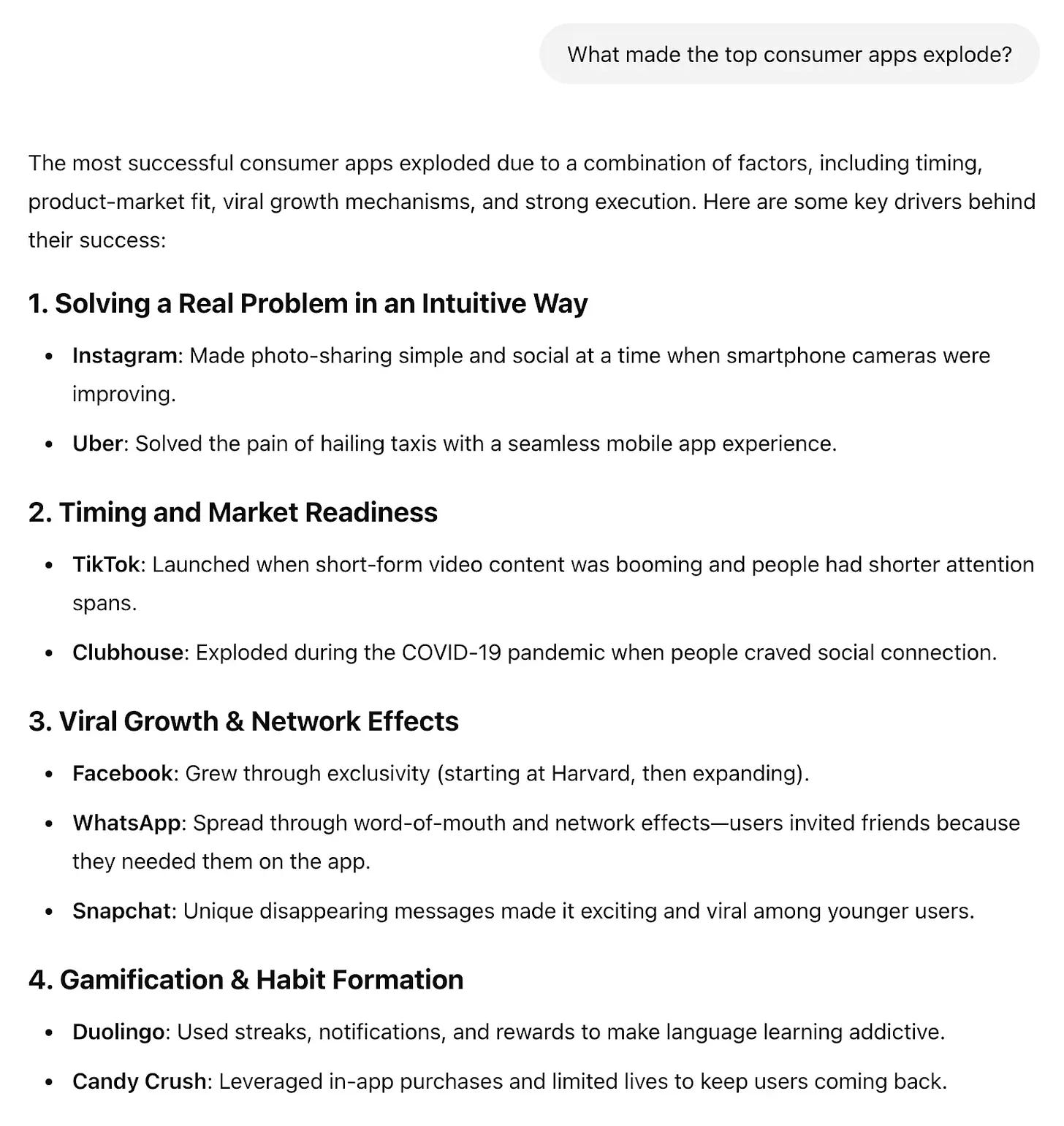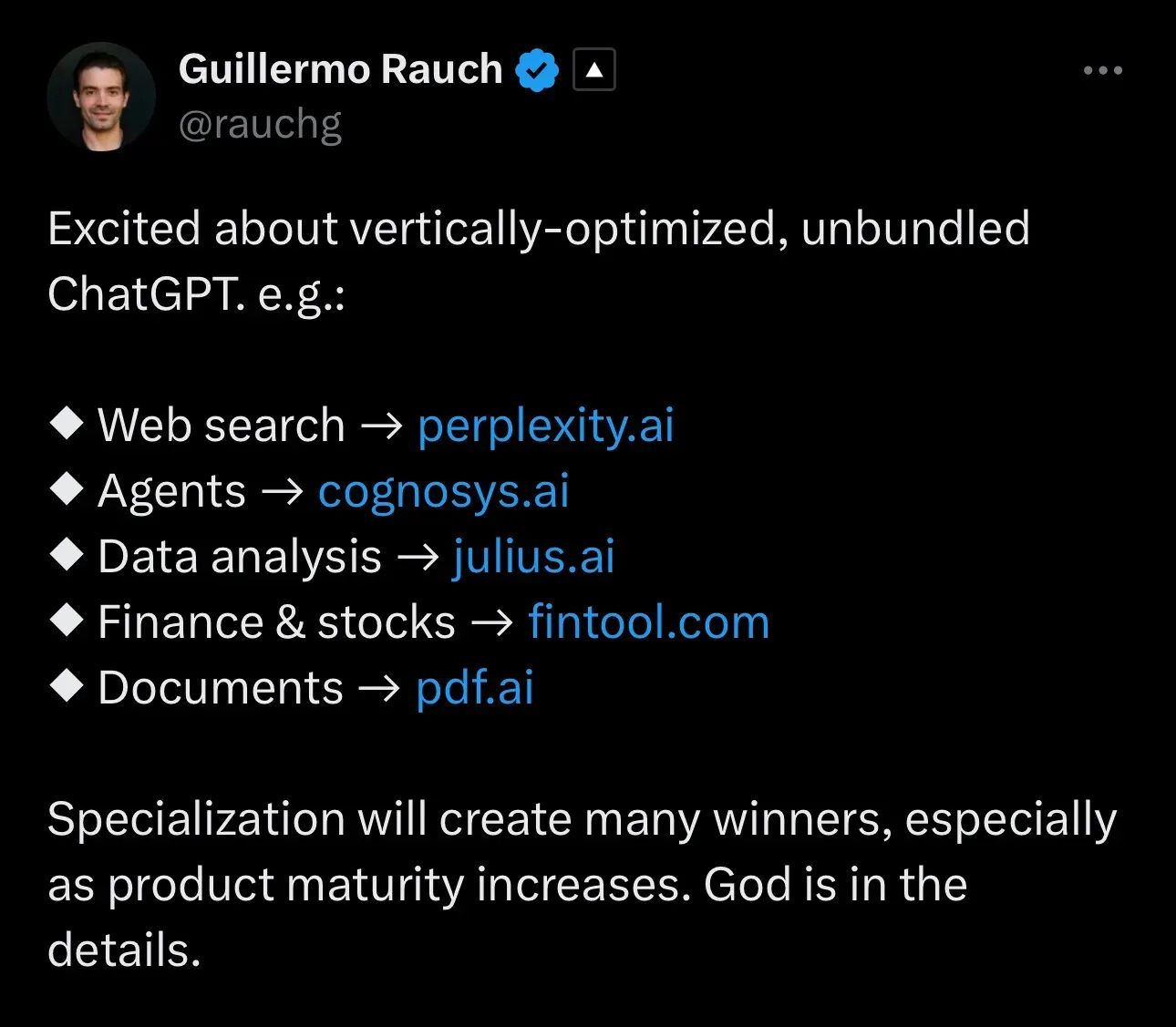Turning ChatGPT Prompts into Profitable Startups: How AI-Generated Ideas Are Creating the Next Wave of Founders
From brainstorm to business model—discover how entrepreneurs are transforming ChatGPT prompts into real companies, MVPs, and AI-native ventures
Starting a business used to mean long nights of building, guessing, and iterating in the dark.
You'd spot a problem, brainstorm solutions, and spend months—sometimes years—developing a product that might not even land.
But that’s changing fast.
AI tools like ChatGPT have evolved from smart assistants into entrepreneurial launchpads. What began as a Q&A tool is now fueling market research, product ideation, and even full-blown app development.
Welcome to the rise of the AI-generated startup—where the right prompt can be the first step to a scalable business…
Brought to you by Vanta: 🚀 Automate Compliance—Live Demo!
Struggling with ISO 27001, GDPR, or SOC 2? Join Vanta’s live demo to see how startups automate compliance & focus on growth.
📅 April 8th | ⏰11 AM BST | 12 PM CESR
✅ Get compliant faster
✅ Reduce manual work
✅ Build trust with customers & investors
Founders use ChatGPT to uncover hidden customer pain points, validate markets, generate content, and automate what used to take entire teams. A single conversation can now spark a real, venture-scale idea.
In this article, you’ll learn:
How prompts become products
The structure of AI-generated business models
The rise of niche tools unbundling ChatGPT
And why the smartest founders are turning AI from assistant into co-founder
If you’re a founder, investor, or builder wondering where the real opportunities lie in AI—this is your roadmap.
Table of Contents
The Potential of ChatGPT Prompts
How AI-Generated Insights Lead to Business Ideas
Transforming a Prompt into a Business Idea
The Unbundling of ChatGPT
Market Opportunities and Challenges for AI-Generated Businesses
Embracing the Shift in App Development
It’s Just the Beginning
1. The Potential of ChatGPT Prompts
Not all ChatGPT prompts lead to helpful conversations. Some prompts spark detailed, insightful responses, while others lead to vague, unhelpful answers. The difference lies in how well the prompt is structured.
A strong prompt is clear and specific. Instead of asking, "Tell me how to be good at marketing," a better prompt would be, "Explain the key components of a successful digital marketing strategy for small businesses." This directs AI to provide targeted insights rather than offer a generic overview. Another thing that helps immensely is adding context. If someone is looking for fitness advice, they might ask, "As a marathon coach, what nutrition plan would you recommend for first-time runners?" The added detail ensures ChatGPT tailors its response to the right audience.
Another powerful technique of prompt generation is assigning a role. If someone prompts ChatGPT to "Act as a career counselor and provide advice on transitioning from a corporate job to entrepreneurship," the AI is more likely to generate useful, structured guidance. Open-ended prompts also lead to more insightful responses.

On social media, some of the most engaging ChatGPT-generated content comes from well-crafted prompts. People use AI to write short, catchy posts, like a 280-character tweet about maintaining a cast-iron pan. Others use it for creative content, generating humorous rap lyrics or crafting viral jokes. One prompt that gained traction asked ChatGPT to assess someone's expertise in a subject by asking a series of questions and then explaining its reasoning.
These prompts aren’t just for entertainment. They highlight how AI can be used for market research, content creation, and even product ideation. When structured effectively, a simple ChatGPT interaction can uncover a business idea.
2. How AI-Generated Insights Lead to Business Ideas
AI isn’t just answering questions; today, countless entrepreneurs are using it to spark business breakthroughs. They are using it to spot trends, find market gaps, and decode why certain companies win. With the right strategy, AI turns raw data into a goldmine of ideas.
Here’s how it works.
AI thrives on patterns. It digs through market reports, social chatter, and news to catch shifts in what customers want. Ask it, “Which industries are pulling in venture capital right now?” and you’ll see where the money’s flowing. Maybe AI spots a surge in AI legal tools or climate-focused fintech. That’s your cue to explore.
But AI goes deeper. It hunts hidden pain points by scouring reviews, forums, and Reddit threads. Imagine scanning thousands of posts to find recurring frustrations. One entrepreneur did this and uncovered unmet needs, like clunky invoicing software that small businesses hate. Ask AI, “What do freelancers gripe about with project management apps?” The answer might highlight poor mobile features or hidden fees. These gaps become launchpads for new solutions.
Another powerful use of AI is reverse-engineering successful businesses. Instead of starting from scratch, founders can ask AI to break down what makes top brands work. Instead of guessing, ask: “What made the top consumer apps explode?” Take it a step further in your prompt generation and AI dissects pricing, marketing tricks, and user retention hacks. Compare winners to failed rivals, and you’ll see what works.

Forget gut feelings or year-long research marathons. AI gives entrepreneurs a head start. Test ideas fast, spot opportunities early, and build where others haven’t looked. A sharp prompt can reveal a million-dollar concept. Nail the execution, and you’ll not just be starting a business, but filling a hole in the market.
3. Transforming a Prompt into a Business Idea
Imagine someone aiming to discover their personal fashion style. They start by engaging ChatGPT with a specific prompt: "Based on my height, weight, preferred color schemes, and body shape, can you recommend a personal style guide?" ChatGPT responds with tailored fashion advice, considering the provided attributes. This interaction sparks an idea: developing a fashion-assistant app that offers personalized style recommendations.
Development of the Fashion-Assistant App:
Personalized Style Profiles: Users input their physical attributes and style preferences. The app analyzes this data to create customized fashion suggestions, helping users identify styles that suit them best.
Wardrobe Management: The app allows users to catalog their existing clothing items. By understanding what's already in their closet, the app can suggest new combinations and identify gaps that could be filled with new purchases.
Shopping Recommendations: Leveraging AI, the app curates shopping suggestions aligned with the user's style profile and existing wardrobe. It provides links to retailers, streamlining the shopping experience.
Virtual Outfit Planning: Users can plan outfits for various occasions using the app's virtual wardrobe feature. This helps in visualizing different combinations without the need to try them on physically.
Real-World Example:
This concept isn't purely hypothetical. For instance, the app Style DNA utilizes AI to analyze user-uploaded selfies, creating personalized style profiles. It offers tailored clothing suggestions, wardrobe management, and shopping recommendations, aligning closely with the envisioned fashion-assistant app.

By transforming a simple ChatGPT prompt into a comprehensive business idea, entrepreneurs can develop innovative solutions that cater to personalized user experiences. This approach demonstrates how AI-generated insights can lead to the creation of valuable and user-centric applications.
4. The Unbundling of ChatGPT
ChatGPT has become the go-to tool for everything from drafting emails to brainstorming ideas. But as people dive deeper, they’ve started spotting tasks that need more focused tools. This shift, called the “unbundling” of ChatGPT, isn’t new. Think of Excel. It began as a general data analysis tool and then sprouted specialized apps for finance, project management, and more. Remember early spreadsheets? People stretched Excel to track projects or crunch data. Soon, niche tools emerged for those exact jobs, birthing today’s vast B2B SaaS landscape.
ChatGPT is on a similar path. Users are finding unique needs that generic AI chats can’t handle smoothly. That’s fueling a wave of tailored AI apps built for specific jobs.
Take podcasters, for example. Turning a transcript into catchy social posts is doable with ChatGPT, but it’s cumbersome. You often still need to copy, paste, and tweak. Now, dedicated tools automate this. Paste a transcript, and voilà! You’ll have more polished posts ready to publish without too many extra steps
This shift shows AI is growing up. As people weave AI into daily work, they want tools that fit like gloves. Specialized apps aren’t just faster, they put advanced tech within reach for everyone, not just experts.

The move from “do-it-all” AI to niche tools is natural. Our needs evolve, and problems and solutions get more specific. The market answers. And just like Excel’s legacy, ChatGPT’s unbundling will likely leave us with a richer, smarter tech world.
5. Market Opportunities and Challenges for AI-Generated Businesses
AI-generated businesses are expanding fast. Some niches offer strong opportunities, while others are already becoming crowded.
Opportunities for AI-Generated Businesses
One of the biggest opportunities is in AI-powered personal assistants. People want faster, smarter ways to organize their lives. AI can help manage schedules, recommend products, and even draft responses for emails or messages. Apps that refine these capabilities for specific audiences, like executives, students, or freelancers, have strong potential.
AI-driven content creation is another growing area. Businesses need fresh content constantly. AI tools that generate blogs, social media posts, and marketing copy are in demand. But the real opportunity lies in industry-specific AI writers. A legal AI content generator or a real estate listing assistant would provide more value than a generic tool.
Healthcare and wellness applications also stand out. AI-powered symptom checkers, fitness coaches, and mental health chatbots are gaining traction. These solutions need expert oversight, but demand is high. Entrepreneurs who combine AI with real-world medical expertise could build valuable, trusted products.
Challenges and Market Saturation for AI-Generated Businesses
Despite these opportunities, the AI-generated business space is already facing market saturation in certain sectors. Many AI startups are launching tons of applications and similar ideas. AI-powered chatbots, writing assistants, and design tools already flood the market. To stand out, businesses need a clear niche, unique data sources, or integrations that make them indispensable.
Another challenge is trust and accuracy. AI is still at the age where it makes mistakes. Productizing an AI that generates legal contracts or financial advice, for example, is a higher-risk because it must be precise. Businesses operating in more sensitive or regulated industries will still need plenty of human oversight to ensure quality and accuracy.
Regulation of AI is also evolving. While currently there are no federal regulations of AI in the US, governments are watching AI businesses closely. Entrepreneurs need to stay updated on data privacy laws and AI compliance rules as this landscape develops in the future.
AI-generated businesses are full of potential, but execution matters. The best opportunities lie in solving real problems for real, specific people. The strongest businesses won’t just use AI for the sake of ease. They’ll use AI to make something faster, smarter, or more reimagined than anything else on the market.
6. Embracing the Shift in App Development
AI is also transforming app development, making it accessible to everyone. Low-code and no-code platforms are at the heart of this change. They empower people with little technical know-how to build fully functional apps. Think of drag-and-drop interfaces, instant updates, and no complex coding, where what was once just ideas turns into reality fast.
AI coding assistants, like GitHub Copilot, are also revolutionizing the process. They automate tedious tasks, offer smart code suggestions, and catch errors in real-time. Whether you’re a beginner or a seasoned developer, these tools can slash hours off your workflow.
Thinking of using an AI coding assistant yourself? Try these initial steps.
Start with low-code platforms such as MIT App Inventor or Microsoft Power Apps. Their visual builders let you create apps quickly, even if coding feels intimidating.
Next, integrate AI helpers into your routine. Use them to handle repetitive work or generate code snippets. The result is faster development and fewer headaches.
Don’t overlook open-source AI communities, like OpenAI’s Developer Community. It’s a treasure trove to share ideas, learn from others, and tap into free resources. It’s a shortcut to leveling up your skills.
By adopting these tools, you can transform creative ideas into functional apps and also shape how technology further evolves.
7. It’s Just the Beginning
The rise of AI-generated businesses is just beginning. One factor will separate the AI-driven startups that succeed from those that fail: human insight. AI can generate ideas, analyze trends, and even write code, but it lacks instinct. It doesn’t fully understand customer psychology, market timing, or the emotional triggers that make a product take off. Entrepreneurs who pair AI’s speed with human intuition will have the strongest advantage.
Founders who thrive in this space will do more than follow AI’s lead. They will challenge its assumptions, refine its outputs, and inject creativity where AI falls short. The most valuable businesses won’t just automate tasks. They will solve real, painful problems with AI as a tool, not the entire solution.
AI can give you a head start. But building something lasting still takes vision, strategy, and execution. The opportunity is there. The question is: Who will build the billion-dollar AI-native businesses of tomorrow?
🤖 FAQ: AI-Generated Business Ideas from ChatGPT Prompts
What is an AI-generated business idea?
An AI-generated business idea is a concept sparked or structured by tools like ChatGPT. These ideas often emerge from insightful prompts that uncover market gaps, automate services, or productize insights—allowing founders to go from idea to execution faster than ever.
Can ChatGPT actually help you start a business?
Yes. Founders now use ChatGPT to brainstorm startup ideas, analyze competitors, automate workflows, validate markets, and even generate code or marketing copy. It's not just a productivity boost—it's becoming a core part of the ideation and launch process.
How do I turn a ChatGPT prompt into a real startup?
Start with a structured prompt that includes clear context, role-playing (e.g. “Act as a product manager”), and desired output. Then iterate. The best founders use ChatGPT as a thinking partner—turning ideas into prototypes, then layering human insight and execution to build actual businesses.
What’s an example of a real business that started as a ChatGPT prompt?
Apps like Style DNA began with simple user questions around personal fashion, which evolved into personalized AI stylists. Founders used prompts to explore features, market fit, and user pain points—and then built real, revenue-generating tools from there.
What’s “the unbundling of ChatGPT” and why does it matter?
As more people use ChatGPT, niche needs emerge that generic tools can’t serve well. This has led to the rise of vertically-optimized AI apps—like PDF.ai or Cognosys.ai—that solve specific tasks better than broad models. This trend opens huge opportunities for startups to own vertical slices of AI functionality.
What kinds of businesses are best suited for AI-generated ideas?
Startups that solve repeatable problems in content, SaaS, e-commerce, personal productivity, coaching, education, and solopreneur services are ideal. The best opportunities use AI to make something faster, smarter, or more personalized.
Is there still opportunity in the AI startup space, or is it too crowded?
Many generic tools (like chatbots or writing assistants) are already saturated. But there’s huge white space in niche verticals, trusted workflows, and AI that solves specific pain points. The real edge isn’t AI—it’s execution, distribution, and solving real problems better than anyone else.
What’s the difference between AI-assisted and AI-generated businesses?
AI-assisted businesses use tools like ChatGPT to speed up human workflows. AI-generated businesses are born from prompts—where the AI sparks or structures the core product or insight. Both are powerful, but AI-native startups may scale faster with fewer resources.




This was a powerful read—I’ve been immersed in the AI startup space for some time and have a strong grasp of the landscape. I’ve developed a few original systems that are 100% results-driven and built from scratch. But like many non-technical founders, my biggest challenge isn’t ideas—it’s execution. I’m currently navigating the gap between vision and implementation, especially when it comes to building the right team around these systems. If you or someone in your circle helps connect high-potential frameworks with technical talent, I’d love to talk. There’s something here—I just need the right minds on board.
Absolutely true!
But the true power will lie in building agentic networks that split the prompt you provided into various sections, for an agent of relevant expertise to only perform that one task. It could even be the use of the agents that individual companies are building for exactly those subtasks.
That way you are getting high accuracy (due to context loss becoming remote) and the ability to use cheaper (dummer) models as tasks are split.
Use that in any vertical domain you know and the sky is the limit...